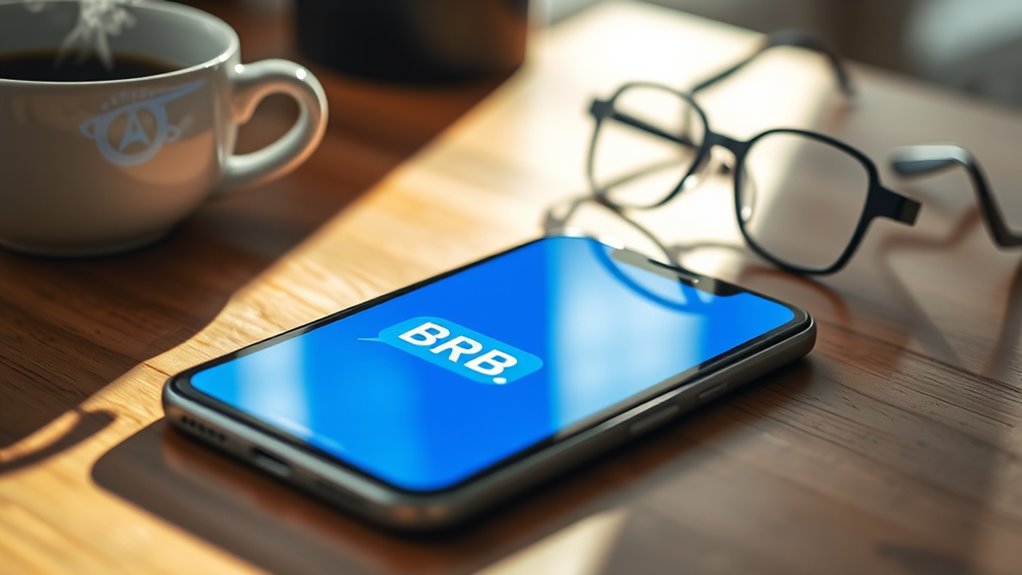BRB in text stands for “be right back.” People use it to quickly let others know they’ll step away for a short time, like grabbing a snack or answering a call. It’s common in casual conversations and often accompanied by emojis to add expressiveness. Remember, misusing BRB in formal settings can seem unprofessional. If you’re curious about how it varies or when to use it properly, there’s more to discover below.
Key Takeaways
- BRB stands for “Be Right Back,” indicating a brief absence in online chat or messaging.
- It is an informal abbreviation commonly used in casual digital conversations.
- BRB signals to others that you’ll return shortly, typically within a few minutes.
- Variations include “BRB! 😊” or “b4,” and emoji shortcuts can add expressiveness.
- In professional contexts, full phrases like “be right back” are preferred over abbreviations.
The Origin of BRB

The abbreviation BRB, meaning “be right back,” likely emerged in the early days of online chatting and text messaging as a quick way to communicate temporary absence. Its history evolution can be traced back to the late 1990s and early 2000s, when internet users sought efficient ways to convey messages in real-time conversations. The linguistic origins of BRB stem from internet slang and shorthand, influenced by the need for brevity in text-based communication. As online chatting grew in popularity, users adopted abbreviations like BRB to save time and keystrokes. Over the years, BRB became a common part of digital language, reflecting broader trends toward concise, informal, and rapid communication in digital spaces. Its creation exemplifies how language adapts to technological changes, including the rise of text-based communication.
Common Contexts for Using BRB

Have you ever wondered when people typically use BRB in conversations? In instant messaging and social media, BRB is a quick way to let others know you’ll be away briefly. It’s common during casual chats when you need to step away from your device but plan to return soon. Using BRB aligns with social media etiquette by maintaining clear communication without disrupting the flow of conversation. You might type BRB when grabbing a snack, answering a quick phone call, or attending to a brief interruption. This abbreviation helps manage expectations and shows respect for others’ time. Overall, BRB is a handy tool to keep conversations smooth, especially in informal settings where quick updates are appreciated. Additionally, understanding common abbreviations like BRB can contribute to more effective communication in digital environments that increasingly incorporate smart IoT technologies for seamless connectivity.
Variations of BRB in Texting
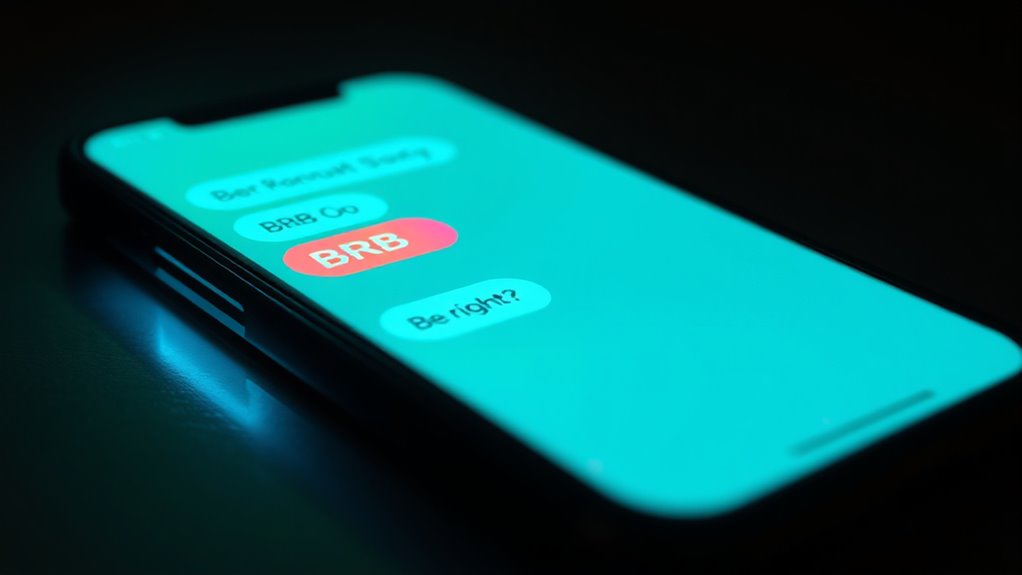
Are there different ways to express BRB in texting? Absolutely. You might see variations like “Be Right Back,” “BRB! 😊,” or even abbreviations like “b4” for “before.” These forms reflect the abbreviation evolution and emoji shortcuts, making messages quicker and more expressive. For example, some common alternatives include:
| Variant | Description |
|---|---|
| BRB! 🚶♂ | Adds an emoji for a visual cue |
| BRT | Shorter, casual version |
| Gotta go, BRB | Combines phrase with abbreviation |
Additionally, these variations allow for personalized communication, helping you to keep your messages engaging and tailored to your style. Whether you choose plain text or emoji shortcuts, the goal remains the same: quickly letting someone know you’ll be back soon.
When to Use BRB Appropriately

Knowing when to use BRB helps keep your conversations smooth and respectful. In digital communication, it’s important to follow chat etiquette by using BRB only when you genuinely need a quick break. Avoid overusing it or sending it when you don’t plan to return soon, as this can confuse others or seem dismissive. Use BRB when you’re stepping away temporarily, like to grab a snack or answer the door, and then rejoin the chat promptly. If your break will be longer, consider sending a message explaining that you’ll be away for a while. Proper timing guarantees your message remains clear and respectful, maintaining positive communication and preventing misunderstandings in your online interactions. Additionally, understanding the appropriate use of abbreviations can improve your communication clarity and help you appear more considerate to others.
Alternatives to BRB for Quick Breaks
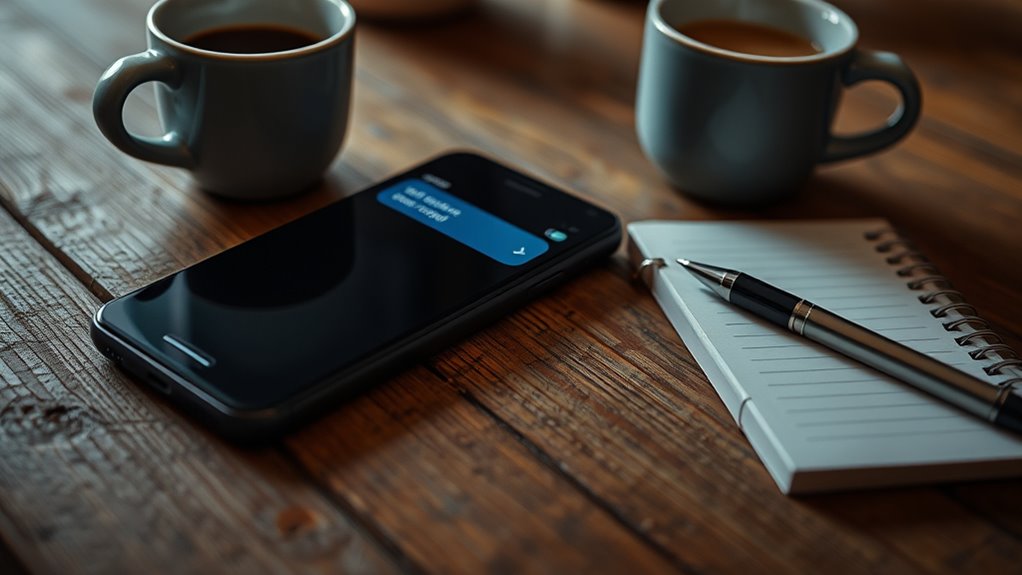
Looking for quick ways to signal you’re stepping away without using BRB? You can use alternative abbreviations or emoji replacements to keep communication clear and casual. Here are three options:
- AFK – Commonly used in gaming and online chats, meaning “away from keyboard.”
- BRB variants – Like “BBL” (be back later) or “GTG” (got to go), which indicate you’re temporarily unavailable.
- Emoji replacements – Such as 💤 (sleeping), 🚶♂ (walking away), or ⏳ (taking a pause), to visually convey your absence.
- You can also include communication etiquette to ensure your message remains polite and understood, especially in digital conversations.
These alternatives help you stay polite and transparent while keeping your message brief. Choose what fits your style and context best to ensure your friends or colleagues understand you’re just taking a quick break.
Misunderstandings and Misuses of BRB
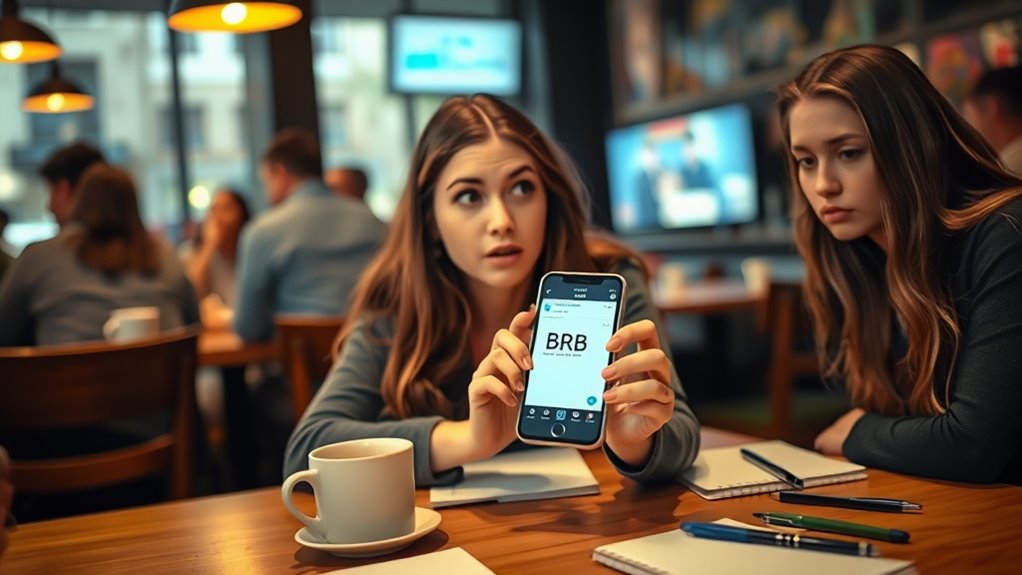
You might have misunderstood what BRB really means or used it in the wrong situation. Sometimes, people think it indicates a quick return, but it can be taken as a longer absence or even a permanent break. Recognizing these common mistakes helps avoid confusion and keeps your messages clear. Additionally, understanding communication etiquette ensures that your message is interpreted correctly and appropriately.
Common Misinterpretations of BRB
One common misinterpretation of BRB is assuming it always means “be right back” in a literal sense, leading some to think the person will return within seconds or minutes. This can cause emotional misinterpretations, where you might feel ignored or frustrated if the person takes longer than expected. Additionally, technical misunderstandings can occur, such as believing BRB is a formal statement rather than a casual abbreviation. To clarify, keep in mind:
- BRB might be used loosely, not indicating an exact timeframe.
- It’s often a polite way to pause the conversation, not necessarily a promise to return immediately.
- People may use BRB in various contexts, so don’t assume intentions solely based on the abbreviation.
- Understanding the context of communication helps prevent unnecessary confusion or miscommunication.
When BRB Is Used Incorrectly
Misusing BRB can lead to confusion or frustration, especially when its meaning is misunderstood. In professional settings, using BRB incorrectly might seem unprofessional or cause coworkers to doubt your seriousness. For example, saying “BRB” during a formal email or meeting can come across as dismissive or careless. In casual misuse scenarios, people sometimes use BRB for too long, like hours or days, which defeats its purpose of quick communication. Sometimes, users forget that BRB means they’ll return shortly, not hours later. These mistakes can create misunderstandings about your intentions or availability. To avoid confusion, use BRB appropriately—short pauses in conversations or chats—and avoid misusing it in contexts where clarity and professionalism matter.
Cultural Differences in Using BRB

Cultural norms influence how people use BRB, with some cultures favoring more formal language and others opting for casual chats. You might notice differences in how quickly or openly you use BRB in various settings. Understanding these variations can help you communicate more effectively across cultural boundaries. Additionally, the choice of dog names like preppy or Irish names can reflect cultural preferences and personal style.
Cultural Variations in BRB Usage
Have you ever noticed that the way people use BRB varies across different cultures? These cultural nuances influence how quickly and casually you might see BRB used or understood. In some regions, BRB is seen as a casual, friendly phrase, fitting seamlessly into everyday chat. In others, it may seem more formal or even confusing, depending on regional expressions. Here are some key points:
- In Western countries, BRB is often used among friends to signal a quick pause.
- In Asian cultures, similar abbreviations might be less common, with more emphasis on explicit communication.
- Cultural norms around immediacy and politeness shape how and when BRB is employed, reflecting regional expressions of communication style. Understanding these variations helps you navigate cross-cultural conversations more effectively.
Formal vs. Informal Contexts
While BRB is generally seen as an informal abbreviation, its usage can vary markedly depending on the context and cultural expectations. In casual communication, especially among friends or peers, using BRB is common and accepted. However, in formal language settings like professional emails or official correspondence, it’s best to guarantee abbreviations like BRB and opt for full phrases such as “be right back.” This shows respect for the seriousness of the situation and maintains professionalism. Recognizing the difference between informal and formal contexts helps you communicate appropriately across diverse environments. When in doubt, choose clear, complete sentences over abbreviations to ensure your message is understood and aligns with cultural expectations. Additionally, understanding global communication norms can further improve how you adapt your language in different settings.
Tips for Recognizing and Responding to BRB
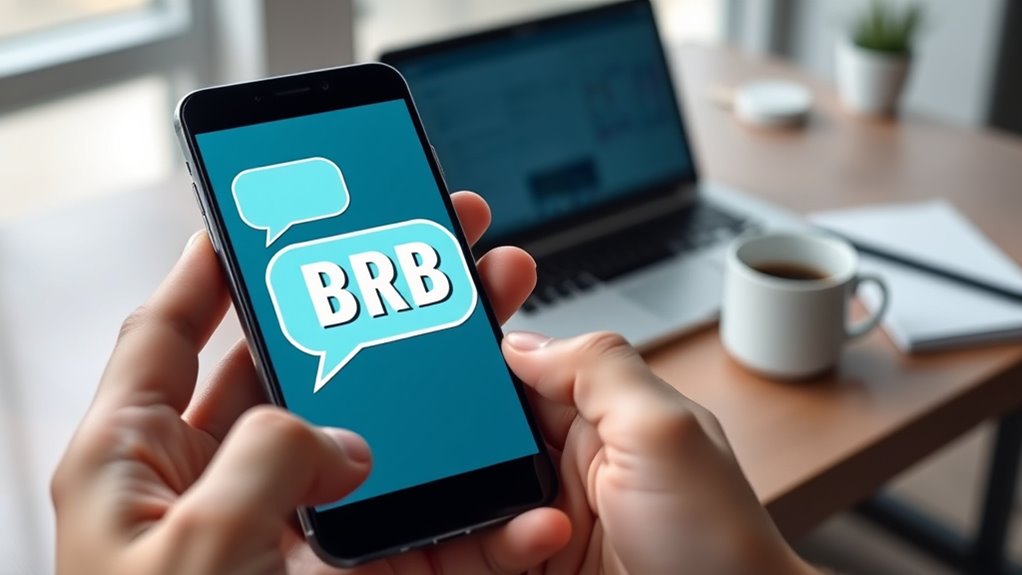
How can you tell when someone’s about to say BRB and respond appropriately? Pay attention to their response etiquette and digital communication cues. Usually, they might give a quick explanation or say “BRB” before leaving the chat. To handle this smoothly, keep these tips in mind:
- Acknowledge briefly and politely, such as “No problem, I’ll wait.”
- Understand that BRB indicates a short break, so avoid over-responding or demanding immediate replies.
- When they return, greet them casually and continue the conversation naturally.
- Recognizing the raw food diet trend can help you understand different contexts in which BRB might be used, especially in health-related discussions.
Recognizing BRB helps you respond appropriately, showing respect for their break. It also keeps your digital communication clear and courteous, maintaining smooth interactions even when pauses happen unexpectedly.
Frequently Asked Questions
Can BRB Be Used in Formal or Professional Communication?
You generally shouldn’t use “BRB” in formal settings or professional communication. It’s a casual abbreviation best suited for informal chats with friends or family. In professional environments, sticking to complete words like “be right back” shows respect and maintains professionalism. Using “BRB” in formal emails or messages might appear unprofessional or careless, so always opt for more formal language in those contexts.
How Quickly Should I Respond After Someone Says BRB?
When someone says BRB, aim to respond within a few minutes unless the message indicates urgency. Your response timing should match the urgency expectations; if they seem in a rush, reply promptly. Otherwise, a quick message acknowledging their return shows you’re attentive. Keep in mind, timely replies demonstrate respect and help maintain smooth communication, especially if the conversation is ongoing or important.
Is BRB Appropriate to Use With Strangers or Just Friends?
You can use BRB with strangers in appropriate settings like casual conversations or informal chats, but it’s best to avoid it in professional or formal contexts. When chatting with friends, BRB feels natural and friendly. Always consider the tone and relationship; if you’re unsure, a simple “briefly away” or just saying you’ll be back might be more suitable. Keep your communication respectful and context-appropriate.
Are There Any Age Groups That Commonly Use BRB?
You might notice that BRB is like a secret handshake among teenagers and young adults, making it wildly popular in age-related slang. Older generations often find it adorable or confusing, highlighting stark generational differences. While teens and millennials use it almost daily to stay connected, older folks might see it as unnecessary or even childish. So yes, BRB is most common among younger age groups, reflecting the lively, fast-paced world they thrive in.
How Does BRB Differ From Similar Abbreviations Like TTYL or GTG?
BRB differs from abbreviation variations like TTYL or GTG mainly in context of usage. BRB means you’ll be right back shortly, often during a conversation or chat. TTYL (Talk To You Later) suggests you’ll connect again later, while GTG (Got To Go) signals you’re leaving soon. You use BRB when stepping away temporarily, whereas TTYL and GTG imply ending or pausing the conversation for a longer or immediate break.
Conclusion
Next time you see “BRB” flicker across your screen like a quick wink, remember it’s more than just letters—it’s a promise to return. Like a brief pause in a lively conversation, it hints at your temporary exit and eventual comeback. So, when you type “BRB,” picture yourself stepping away through a doorway, knowing your message is waiting patiently for your return, ready to continue the story whenever you’re back.
